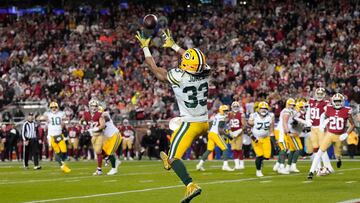What is the two-point conversion success rate in the NFL? History and strategy behind the play
The two-point conversion is one of the more curious aspects of football. Here we take a look at what it’s all about and why teams are using it more and more.

With the NFL’s Conference Championships just around the corner, football fans know that there will soon be plenty of high-stakes moments coming their way. One, in particular, will be what their team decides to do after scoring a touchdown. Should it kick or go for a two-point conversion?
What is the two-point conversion?
Simply put, a two-point conversion is a play in football that a team attempts instead of kicking the ball for a one-point conversion after scoring a touchdown. As is the case when scoring a standard touchdown, the team in possession of the ball must run a play from the line of scrimmage close to the opponent’s goal line and advance the ball across the line. Should the team succeed in doing so, it is awarded two additional points on top of the six that it received for the touchdown, making it a total of eight points.
The NFL switched things up in 2014
Since its introduction in 1994, the two-point conversion has caused quite a bit of discussion. Yet, it wasn’t until 2014 that things got quite interesting after the NFL experimented with moving the extra point distance back in the first two weeks of the preseason. At the start of the very next season, owners voted to move the scrimmage line for extra point kicks back 13 yards to the 15-yard line. To that end, the 2015 season was used as a one-year trial of the new rules, with the change being made permanent the season after. “We tried to add some skill to the play, which is the reason why we moved it back to the 15, and then the other element is, how do we create a more exciting play? And so to give the defense an opportunity to score, it adds an element there, as well as obviously incentivizing teams to go for two,” said NFL Competition Committee member Rick Smith, who was Houston Texans general manager at the time.
OK, but what about the success rate of two-point conversion?
As you can probably guess the two-point conversion was initially very popular among coaches back in the 90s, but it didn’t take long for it to fade as teams reverted to the standard procedure of kicking after a touchdown. In recent seasons, however, we’ve seen an uptick in the number of two-point conversion attempts, which as you can imagine has offered a welcome dose of strategy to fans. You may recall Week 17′s clash between the Detroit Lions and Dallas Cowboys, a game in which we saw three consecutive two-point conversion attempts in the last few seconds of the game. Where numbers are concerned, two-point conversions have been successful about 47.5% of the time that they’ve been attempted since 2015 i.e., roughly half of the extra point kick conversion rate which sits at 95%.
Is there a link between those two numbers?
That’s a tough question to answer. For starters, who can say what if any mathematical calculations were used to support the league’s decision to move the ball to the 15 for teams who opt to kick? Logically speaking, the closer the ball is, the more kicking would seem like the better option, and the further away it is, then a two-point conversion must surely be the better option. Either way, the NFL made it clear that the decision was based on the idea of increasing the entertainment value. This of course brings us to the question of strategy.
What’s the strategy involved in two-point conversions?
While there is debate about this, there does seem to be some method to the madness where the decision of when to attempt a two-point conversion is concerned and it appears to be based on math. For example, if a team scores a touchdown that leaves it trailing by 5 points, the obvious option would be to go for two. A successful conversion would leave the team within a field goal of tying the score. Conversely, a successful kick would still leave a deficit of 4 or 5. If on the other hand, a team scores a touchdown and is behind by 4 points, then things get a little complicated. According to an analysis by FiveThirtyEight, teams should go for two especially late in games.
Is math the key in two-point conversion strategy?
Not exactly, but when looking at the findings of statisticians alongside the actions of coaches and their teams, there seems to be some correlation. While we haven’t seen a significant increase in the number of attempts, we have definitely seen an increase in teams opting for two when the numbers support doing so. If we consider the above-mentioned example of a team that is down by 5, it’s interesting to note that between 2010 and 2013, teams attempted two-point conversions in that situation 25% of the time. In the last three seasons alone, we’ve seen that figure more than double as it now stands at 56%.






